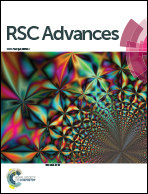Dopamine and silane functionalized barium titanate with improved electromechanical properties for silicone dielectric elastomers
Abstract
In this study, a combination of bio-inspired poly(dopamine) (PDA) deposition and γ-methacryloxypropyl trimethoxy silane (KH570) grafting is proposed to functionalize the surface of barium titanate (BT) with the aim to improve the electromechanical properties of silicone dielectric elastomers. Inspired by the composition of adhesive proteins in mussels, we used dopamine self-polymerization to form a thin adherent PDA film onto the surface of BT. KH570, which contains double bonds, was then grafted through reactions with the hydroxyl and indole groups of the PDA surface. The surface composition and microstructure of the modified BT particles were characterized by X-ray photoelectron spectroscopy (XPS), Fourier transform infrared (FTIR) spectroscopy, high resolution transmission electron microscopy (HR-TEM), and thermogravimetric analysis (TGA). The results show that PDA grafted with KH570 (denoted as PDA + KH570) was successfully coated on the BT particles. In addition, the PDA + KH570 layer containing double bonds not only improved the dispersion of the fillers in the polymer matrix but also helped in the formation of strong interfacial interactions between the BT particles and silicone elastomer matrix, which led to an improved dielectric constant and actuated strain. Finally, the tensile strength of all the silicone dielectric composites is larger than 5 MPa, which is much higher than commercial acrylic dielectric elastomers. This is a big advantage for the practical application of a dielectric elastomer.


 Please wait while we load your content...
Please wait while we load your content...